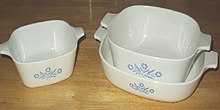Corelle Brands
Corelle Brands, LLC is an American kitchenware products maker and distributor based in Downers Grove, Illinois.
[1] The company began as an unincorporated consumer products division of Corning, Inc. in 1915 with the invention of heat-resistant glass bakeware sold under the Pyrex brand.
In November 1994, Corning and the CCPC sold its European, Russian, Middle Eastern and African consumer products businesses to Newell.
Kenneth Wilkes was named president and CEO in August 2017, following a change in control in April to private equity firm Cornell Capital.
[7] In August 2018, Corelle Brands announced it would be investing $50 million over the next four years to update its Corning plant and expand its workforce.
[10] On June 2, 2020, the company announced Ben Gadbois as the replacement for Kenneth Wilkes, who retired but will continue to serve on the board of directors.
[13] During bankruptcy proceedings, the company sold its appliance business ("Instant" branded products) to Centre Lane Partners.
[17] On September 4, 2024 Anchor Hocking (a Centre Lane Partners company) announced that they will be closing the Pyrex Manufacturing Plant in Charleroi, PA[18] Corelle Brands products were typically sold in supermarkets in the USA, and by some high-end retailers catering to upper class consumers in parts of Asia, Europe, and South America.
Corelle Brands manufactures products under names such as: On June 1, 2004, WKI Holding Company, Inc., which operates principally through its subsidiary World Kitchen, Inc., announced that it had completed the sale of OXO International to Helen of Troy Limited for over $273 million in cash.
Visions was temporarily unavailable in the United States from 2004 until 2006 but has otherwise been produced non-stop for nearly 40 years.In 1930 Chicago Cutlery was incorporated by Alfred Paulson.
Due to its high thermal shock resistance, Corning Ware could be used to store food in a freezer and then taken directly to a stove, placed under a broiler or in an oven (both conventional and microwave).
[28][29] Statistical Assessment Service (STATS) analyzed the data available and found that the most common way that users were injured by glassware was via mechanical breakage, being hit or dropped, and that "the change to soda lime represents a greater net safety benefit.

